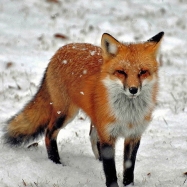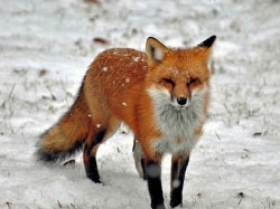
Red Fox
Vulpes vulpes
Animal Behavior: Red foxes are solitary animals and do not form packs like wolves. During some parts of the year adjacent ranges may overlap somewhat, but parts may be regularly defended. In other words, Vulpes vulpes is at least partly territorial. Ranges are occupied by an adult male and one or two adult females with their associated young. Individuals and family groups have main earthen dens and often other emergency burrows in the home range. Dens of other animals, such as rabbits or marmots, are often taken over by foxes.
Eating Habits: Red foxes are essentially omnivores. They mostly eat rodents, eastern cottontail rabbits, insects, and fruit. They will also eat carrion. Red foxes also store food and are very good at relocating these caches. Red foxes have a characteristic manner of hunting mice. The fox stands motionless, listening and watching intently for a mouse it has detected. It then leaps high and brings the forelimbs straight down forcibly to pin the mouse to the ground. They eat between 0.5 and 1 kg of food each day.
Range: Red foxes utilize a wide range of habitats including forest, tundra, prairie, desert, mountains, farmlands, and urban areas. They prefer mixed vegetation communities, such as edge habitats and mixed scrub and woodland. They are found from sea level to 4500 meters elevation.
Conservation Efforts: Overall, red fox populations are stable and they have expanded their range in response to human changes in habitats.
Animal Facts: Coloration of red foxes ranges from pale yellowish red to deep reddish brown on the upper parts and white, ashy or slaty on the underside. The lower part of the legs is usually black and the tail usually has a white or black tip. Two color variants commonly occur. Cross foxes have reddish brown fur with a black stripe down the back and another across the shoulders. Silver foxes range from strong silver to nearly black and are the most prized by furriers. These variants are about 25% and 10% of red fox individuals, respectively. Red foxes, like many other canid species, have tail glands.
